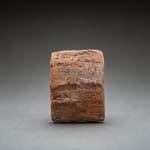Sumerian Cuneiform Tablet, 2042 BCE
Clay
1.8 x 2.5
LK.135
Further images
Sumerian cuneiform is one of the earliest known forms of written expression. First appearing in the 4th millennium BC in what is now Iraq, it was dubbed cuneiform (‘wedge-shaped’) because...
Sumerian cuneiform is one of the earliest known forms of written expression. First appearing in the 4th millennium BC in what is now Iraq, it was dubbed cuneiform (‘wedge-shaped’) because of the distinctive wedge form of the letters, created by pressing a reed stylus into wet clay. Early Sumerian writings were essentially pictograms, which became simplified in the early and mid 3rd millennium BC to a series of strokes, along with a commensurate reduction in the number of discrete signs used (from c.1500 to 600). The script system had a very long life and was used by the Sumerians as well as numerous later groups – notably the Assyrians, Elamites, Akkadians and Hittites – for around three thousand years. Certain signs and phonetic standards live on in modern languages of the Middle and Far East, but the writing system is essentially extinct. It was therefore cause for great excitement when the ‘code’ of ancient cuneiform was cracked by a group of English, French and German Assyriologists and philologists in the mid 19th century AD. This opened up a vital source of information about these ancient groups that could not have been obtained in any other way.
Cuneiform was used on monuments dedicated to heroic – and usually royal – individuals, but perhaps its most important function was that of record keeping. The palace-based society at Ur and other large urban centres was accompanied by a remarkably complex and multifaceted bureaucracy, which was run by professional administrators and a priestly class, all of whom were answerable to central court control. Most of what we know about the way the culture was run and administered comes from cuneiform tablets, which record the everyday running of the temple and palace complexes in minute detail, as in the present case. The Barakat Gallery has secured the services of Professor Lambert (University of Birmingham), a renowned expert in the decipherment and translation of cuneiform, to examine and process the information on these tablets. The following is a transcription of his analysis of this tablet:
‘The text is an administrative document of the Third Dynasty of Ur, dated to the 5th year of Amar-Suena, third king of the dynasty, c. 2042 B.C. It is a list of items issued to 10 men setting off on a journey.
Translatio
10 men: 120 sila of barley flour each. 2 leather bags each. 2 leather water bottles each. 2 pairs of Habban-leather sandals each. 2 …….. each. 1 sila of oil each. 1 sila of salt each: for a journey. Month: Shugarra, 18th day. Bur-Mamma, commissar, took an oath in the king’s name. Seal inscription. Bur-mamma, son of Erra-…….., clerk ……. Year: En-unugal-anna was installed as high priestess of Inanna.
The sila was a measure of capacity, about .85 of a litre, so the load of barley flour being taken by each man was very considerable. Also the provision of two pairs of sandals each implies a long journey, similarly the more than 1 ½ litres of salt. Ever more strange is the taking of an oath by the commissar. Was he perhaps leader of the expedition and had to accept responsibility that these articles were used strictly for the men on the journey? Obviously the journey was in foreign parts where the authority of the Ur III government did not apply. This is a rare and interesting tablet, not easily paralleled in other known tablets of this period.’
Cuneiform was used on monuments dedicated to heroic – and usually royal – individuals, but perhaps its most important function was that of record keeping. The palace-based society at Ur and other large urban centres was accompanied by a remarkably complex and multifaceted bureaucracy, which was run by professional administrators and a priestly class, all of whom were answerable to central court control. Most of what we know about the way the culture was run and administered comes from cuneiform tablets, which record the everyday running of the temple and palace complexes in minute detail, as in the present case. The Barakat Gallery has secured the services of Professor Lambert (University of Birmingham), a renowned expert in the decipherment and translation of cuneiform, to examine and process the information on these tablets. The following is a transcription of his analysis of this tablet:
‘The text is an administrative document of the Third Dynasty of Ur, dated to the 5th year of Amar-Suena, third king of the dynasty, c. 2042 B.C. It is a list of items issued to 10 men setting off on a journey.
Translatio
10 men: 120 sila of barley flour each. 2 leather bags each. 2 leather water bottles each. 2 pairs of Habban-leather sandals each. 2 …….. each. 1 sila of oil each. 1 sila of salt each: for a journey. Month: Shugarra, 18th day. Bur-Mamma, commissar, took an oath in the king’s name. Seal inscription. Bur-mamma, son of Erra-…….., clerk ……. Year: En-unugal-anna was installed as high priestess of Inanna.
The sila was a measure of capacity, about .85 of a litre, so the load of barley flour being taken by each man was very considerable. Also the provision of two pairs of sandals each implies a long journey, similarly the more than 1 ½ litres of salt. Ever more strange is the taking of an oath by the commissar. Was he perhaps leader of the expedition and had to accept responsibility that these articles were used strictly for the men on the journey? Obviously the journey was in foreign parts where the authority of the Ur III government did not apply. This is a rare and interesting tablet, not easily paralleled in other known tablets of this period.’





